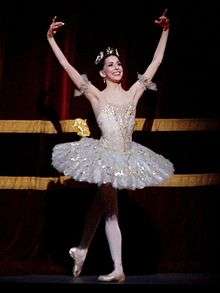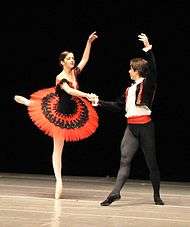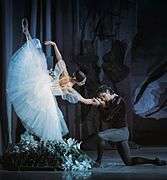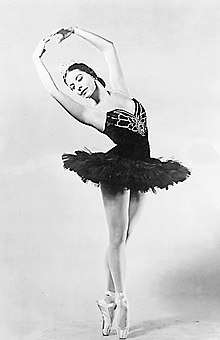Tutu (clothing)

The modern tutu is a dress worn as a costume in a ballet performance, often with attached bodice.[1] It may be made of tarlatan, muslin, silk, tulle, gauze, or nylon. Modern tutus have two basic types: the Romantic tutu is soft and bell-shaped, reaching the calf or ankle; the Classical tutu is short and stiff, projecting horizontally from the waist and hip.[2]
Etymology
The derivation of the word tutu is unknown. The word was not recorded anywhere until 1881. One theory is that it is simply derived from the word tulle (one of the materials from which it is made).
Another theory is that it derives from French babytalk for bottom (cucul): during that era, the abonnés (rich male subscribers at the Paris Opera Ballet) were encouraged to mix with the ballet girls in the foyer, and arrange assignations.[3] It is suggested the expression came from the abonnés playfully patting the back of the tulle dress with the saying pan-pan cucul (French for I'll spank your bottom).
A third, related theory suggests a derivation from the more vulgar French word, "cul" (which can be used to refer to the bottom or genital area). During this era, women (including dancers) wore pantalettes as underwear, which were open at the crotch. The abonnés favoured the very front rows in the hope of a scandalous view, and the skirt was modified for that reason. This is supported by the description by nineteenth-century balletomane, Charles Nuitter, who defined tutu as "a slang term for the very short petticoat worn by danseuses in the interest of modesty."[4]
History

The skirt that became known as the Romantic tutu made its first appearance in 1832 at the Paris Opera, where Marie Taglioni wore a gauzy white skirt cut to reveal her ankles, designed by Eugene Lami in La Sylphide.[5] From the late 19th century onwards, the tutu was steadily shortened, for ease of movement and to show off the dancer's legs.[6]
Fashion designers have often been involved in design for ballet.[7] Fashion designers Cecil Beaton in England, Christian Lacroix in France, and Isaac Mizrahi in the United States have all designed tutus. Among the leading makers of tutus around the world, few designers have matched the reputation of Barbara Karinska (1886-1983), costumer for the New York City Ballet for many years, She designed and constructed tutus of extraordinary beauty and durability.[8]
Image gallery





References
- ↑ Debra Craine and Judith Mackrell, "Tutu," in The Oxford Dictionary of Dance (Oxford University Press, 2000).
- ↑ "tutu - Definition of tutu in US English by Oxford Dictionaries". Oxford Dictionaries - English. Retrieved 7 October 2017.
- ↑ "Flowers of the Gutter: Ballet Companies as Brothels from Paris to Russia - The Weeklings". TheWeeklings.com. Retrieved 7 October 2017.
- ↑ Beaumont, Cyril W. (1959). A French-English Dictionary of Technical Terms Used in Classical Ballet. London: ISTD. p. 4.
- ↑ Ivor Guest, The Romantic Ballet in Paris (Alton, Hampshire: Dance Books, 2008), ISBN 978-1852731199
- ↑ Victoria and Albert Museum (1981). Spotlight: Four Centuries of Costume Design, a Tribute to the Royal Ballet. London: Theatre Museum.
- ↑ Judith Chazin-Bennahum, The Lure of Perfection: Fashion and Ballet, 1780-1830 (New York: Routledge, 2005), ISBN 978-0415970389
- ↑ Toni Bentley, Costumes by Karinska, with a foreword by Edward Gorey (New York: Abrams, 1995), ISBN 978-0810935167
External links
| Wikimedia Commons has media related to Ballet tutus. |